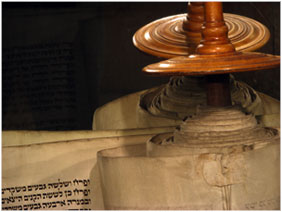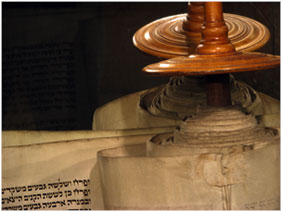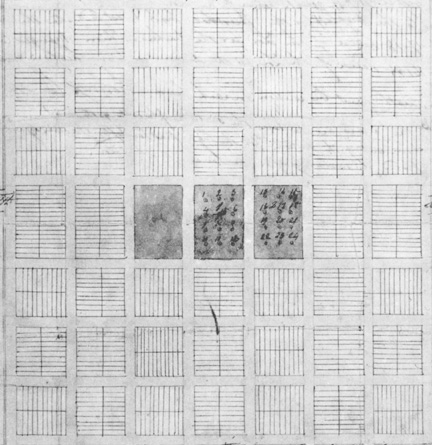-
•
•

2 Samuel 11 Verse 1: What do you make of the fact that the story is set at the time of the year when “kings go forth to battle,” but David sent his army to battle and stayed behind himself? What is the writer telling us about David when he says “But David tarried still at Jerusalem”? (Note: presumably the time when battles could once again commence was at the end of the rainy season, approximately the beginning of May.) Verses 2-5: How do you suppose that David could see Bathsheba bathing? Where do you think people would usually have… Read More
-
•
•
16 responses

I’m going to briefly argue for the general importance and contemporary relevance of the Journal of Discourses. But first, let me say: My grandpa (Max Olsen) is a very good man. Read More
-
•
•
40 responses
This week, the Rochester Stake in New York is sponsoring a special performance of Carol Lynn Pearson’s Facing East, to be followed by a fireside featuring a discussion led by the Rochester Stake President. Notably, the performance is being directed by Jerry Argetsinger, who was the long-time director of the Hill Cumorah Pageant throughout the 90s, and costume design is being handled by Gail Argetsinger, a Tony award-winning costume designer who designed and supervised the construction of thousands of pageant costumes during the 90s. For those unfamiliar with Facing East, it is the story of a Mormon couple who is… Read More
-
•
•
3 responses
We’ve been teaching our oldest son Peter that he’s a big brother to our younger son Jeremy. When Peter learned that Joseph Smith also had a big brother, he fell in love with the concept. Now whenever we go somewhere church-related, he asks, “Will there be a picture of Joseph and Hyrum?” By Robert Gibbons ___ This picture is part of our ongoing series highlighting Mormon images. Comments to the post are welcome; all comments should be respectful. In addition we invite you to submit your own images to the Mormon Image series. Other images in the series can be… Read More
-
•
•
35 responses
Scott at Bloggernacle Times has been putting on a very impressive Behind the Music retrospective about the old Banner of Heaven blog. The hair, the women, the trashed hotel rooms — it’s all there, complete with interviews with band members (Brian G. comes clean about the infamous “no brown M&M’s” contract), groupies band aids, and even the occasional critic. In fact, about the only point that Scott seems to have missed so far is the group’s hidden apologetic purpose. What apologetic purpose, you ask? Only that a widely read book — also widely perceived as hostile towards the church —… Read More
-
•
•
3 responses
Jana Reiss, former T&S guest blogger and author of Mormonism for Dummies, is running a new Mormon blog at Beliefnet: Flunking Sainthood. Put a link in your blogroll (do people still do blogrolls?) and visit often. Having myself previously hosted a Mormon blog at Beliefnet, I have some idea of the challenge the new blog is facing. The problem can be put very simply: (1) few people who aren’t Mormon have much to say about Mormonism, and (2) there aren’t too many Mormons hanging around the Beliefnet site. But it just seems wrong that one of the most popular Internet… Read More
-
•
•
4 responses
Walking hand in hand with my family on Temple Square in April 2009. Taking our one year old daughter for the first time was very special, and as we walked I looked around to ask someone to take our picture. We were alone. As I looked at our shadows, I thought that was a much more powerful image; for me, it invokes the feeling of moving forward and facing the future together. This is my favorite photo from that trip. By Christy D. ___ This picture is part of our ongoing series highlighting Mormon images. Comments to the post are… Read More
-
•
•
40 responses
I finally picked up and read a copy of Simon Southerton’s Losing a Lost Tribe: Native Americans, DNA, and the Mormon Church (Signature, 2004) a couple of weeks ago. Yet I still attended church last week and have not drafted a resignation letter. Inoculation works. There’s nothing particularly new in the book — it summarizes mainstream academic views about the origins of the native inhabitants of the Americas, reviews more recent DNA evidence that confirms the mainstream view, then critiques mainstream LDS beliefs about the Book of Mormon and the peopling of the Americas. It is not a book that… Read More
-
•
•
10 responses

At 3:28 this morning we welcomed a new son into the world. As one would expect, congratulations and well-wishes have come flooding in from friends and family all day. And for all of these we have been moved and grateful. First thing this morning, however, we received a congratulatory gift we hadn’t anticipated. Women housed in the Alexandria Detention Center had sent us a hand-crocheted blanket, cap and set of booties. (In Packer yellow-and-green for my Cheese-head wife no less). Both modern and ancient scripture admonish us to serve the “least” of those among us, noting that doing so is… Read More
-
•
•

I apologize for the rough status of these study notes. They are not yet finished, but they are as good as they are going to get this week. As you read these chapters, ask yourself why they are included in scripture. Do they testify of Christ? If so, how? Do they serve some other purpose? History is important in its own right, but it isn’t clear why this particular history is important as scripture. How would you explain its importance? Perhaps the answer is “Ultimately this isn’t an important story,” but that ought to be our last conclusion rather than… Read More
-
•
•
49 responses
Before I sign off – or am run out of town – I might serve you well by offering a perspective on an extremely interesting conference held last weekend on the USC campus in LA. The conference was titled “Mormon Engagement with World Religions,” and was organized by Randall Paul, founder of the Foundation for Interreligious Diplomacy, and by Brian Birch, head of the LDS chapter of same Foundation. Randall’s vision of the inter-religious conversation is quite rich and distinctive. He is not interested in diluting or understating doctrines in order to commune lamely on some lowest common denominator of… Read More
-
•
•
29 responses
Since my “second-order” questioning elicited little discussion (albeit 200+ responses), let me try to “take it up a notch,” as George Constanza might say (forgive the erudite cultural references). Herewith, the “third order,” the Meta-Meta Meditation on the problem of politics/morality/religion. (I gather my guest privileges will expire before we have a chance to go to the Fourth Order, which would start to make me a little nervous anyway, since I don’t know what the Fifth Order might be.) Anyway, here, from my forthcoming blockbuster, The Responsibility of Reason*, is a fragment of that third-order reflection. (Is it relevant to… Read More
-
•
•
17 responses

I’m in the final semester of an MBA program at Oregon’s Willamette University. I took a job in California a couple months ago. That means I’ve got a killer commute to class. All that to say that my time for deep, theosophical discourse with my wife is limited to the occasional late-night discussion when we both really should be sleeping. Generally these discussions rehash the well-worn topics that have occupied our philosophical speculations over six years of marriage. This last week, though, I was caught flatfooted by an entirely new and vitally important doctrinal disagreement inspired by Geoff J’s post… Read More
-
•
•
15 responses

On May 28, a press conference was held in the South Visitors’ Center on Temple Square to unveil a new public exhibit: a cut-away scale model showing the interior architecture and layout of the Salt Lake Temple. The LDS Newsroom and Deseret News posted detailed stories with additional images; in this post I just want to toss out a few ideas for discussion. Read More
-
•
•
250 responses
OK, now that we’ve basically cleared up any confusion surrounding the ontological status of agency and atonement, let me see what you think about something a little more… political. For many years friends and I had considered the possibility of some kind of political-philosophy oriented educational foundation that would try to help religious people, and LDS in particular, to navigate the world of ideas as these concern politics, broadly understood. What finally got some of us off the dime with this concern was the controversy surrounding the Church’s efforts in favor of Prop 8 in California. Let me first satisfy… Read More
-
•
•
16 responses

A girl I know was considering taking a commissioned sales job at a truck stop. She commented to me, “Maybe I’ll wear a tight shirt and a push-up bra. I bet that would help with my sales numbers.” My immediate reaction was, “Don’t sell yourself like that!” I’m told that there is a correlation between a man’s physical height and his achievement in traditional measures of success (fame, fortune, etc.). I’d bet that there’s a similar correlation for women and bust size. So why would I feel comfortable encouraging a man to use his physical traits to advantage in his… Read More
-
•
•
31 responses
A dear friend–who is a single, never-married, 40-something, extremely faithful LDS woman–emailed this to a few friends. I share it with her permission, having edited out identifying information: Read More
-
•
•
Though the lesson doesn’t include chapters 12 and 14, the manual recommends them as supplemental reading and I agree. We need to read them to see the full story. There is quite a bit in this section, from the choice of Saul as King, to his usurpation of Samuel’s authority and consequent loss of authority, to the choice of David to replace him, to Saul’s madness, to the story of David slaying Goliath. Rather than try to cover all of that material, these study questions will focus on chapters 9-10, 13, and 16: Saul’s selection and downfall; David’s election. Chapter… Read More
-
•
•
16 responses
Thanks for some good suggestions, objections, discussion re. my first post. Let me try to kick the can down the road just a bit further with a few more reflections: First, the Fortunate Fall — that the Fall is good news, is extremely well attested in quite authoritative (or at least, to me, impressive) statements by LDS authorities. To put it simply: to be fallen and then redeemed is better than never to have fallen. I don’t have my sources here to document this – feel free to help me here if you wish – but I have little doubt… Read More
-
•
•
5 responses

Even Dracula and his minions deserve to hear about the Book of Mormon. by Dan Dubei Read More
-
•
•
20 responses
As one who has turned into something of Boozer-apologist this past year in the face of attacks on him by some disgruntled Jazz fans, I was buoyed to see an account of a recent Boozer interview yesterday in the Deseret News. When the Miami-area sports station host interviewing Boozer called Utah “gorgeous” but “a horrible place to live, horrible,” Boozer said: “Nah, it’s not that bad. You know, I’m raising my kids out there. It’s pretty nice. We have a good time out there with our basketball team, successful of course. That’s the frontcourt of it, the most important thing… Read More
-
•
•
The scriptural problem of evolution is well understood. The creation accounts in Genesis and other scripture are not obviously describing speciation through natural selection. Read More
-
•
•
22 responses
Thanks, Marc for the introduction, and for the opportunity to converse with friends old and new at T & S. Before I annoy (at least some of) you with some political reflections, let me run past you some thoughts on agency and atonement that occurred to me in trying to teach Religion 121 (Book of Mormon Part 1) to BYU students. I’m not sure I connected with many of themwith these ontological meditations on Second Nephi 2, but I’m hoping somewhere out there in this cyberspace I might find some interested interlocutors. As I review the question of agency with reference… Read More
-
•
•
2 responses

About 800 Members of the Sacramento California Stake and their friends donated more than 2,000 man-hours at the City of Sacramento’s William Land Park, which has seen its finding cut by 60 percent in recent years and its maintenance staff trimmed from 22 to seven employees. Volunteers focused on numerous work projects, including historic trail restoration, power-washing of park amenities, landscape maintenance, specialized gardening, and the cleaning out of the park’s three ponds. The volunteer service in Land Park has an estimated value of more than $70,000. by John S. McKinney ___ This picture is part of our ongoing series… Read More
-
•
•
7 responses
While Rana Lehr-Lehnardt’s guest run continues, Times & Seasons is happy to introduce our next guest blogger, Ralph Hancock. Ralph is a long-time professor of Political Science at Brigham Young University. He is the author of Calvin and the Foundations of Modern Politics, as well as of numerous edited volumes, articles and chapters. His forthcoming book, The Responsibility of Reason (Rowman & Littlefield), addresses the meaning and limits of reason through a triangulation involving de Tocqueville, Heidegger and Strauss. Ralph has also translated three books (including one with his son Nathaniel) and numerous chapters and articles from French, and has organized… Read More
-
•
•
23 responses

The question of the truth of the church didn’t enter my consciousness until I was about twelve years old. That was the age when I started discussing religion with my school friends. I remember a conversation I had with a friend after school. His family was not religious, and he was curious about my beliefs. I started by explaining to him the one doctrine that resonated the most deeply with me — the three degrees of glory. I remember learning about the three kingdoms in Sunday school and thinking, “Wow, this makes a lot of sense. Of course God isn’t… Read More
-
•
•
138 responses

I credit any awareness I have of gender issues in the church to the challenging, patient, and frank discussions that take place within the bloggernacle. Reading the first-hand experiences shared by many sincere sisters here has forced me to reconsider the paradigm I was comfortable in — the one where men and women have separate but equally valuable roles in God’s plan. Now I’m more inclined to view these strongly typed gender roles as reflective of the church’s situation in a specific time and culture. This week I went with the missionaries to visit a less-active member in our ward.… Read More
-
•
•
One can reasonably argue that the book of Judges shows us the decline of Israel to a situation in which they have to have a king to lead them, and that the treatment of women that we see in Judges is a sign of that decline. One can also argue that Ruth is a response to that theme in Judges. How does the story of Hannah fit into that theme? Chapter 2 Verses 1-10: These verses are a song, perhaps not one that Hannah composed, but one she knew already and applied to herself, much as we might choose to… Read More
-
•
•
Since instituting the “A Mormon Image” series last fall, our submissions have slowed from a glut to a trickle. As a result, we thought we would issue a new call for photographs to be considered for inclusion in the series. The instructions for submissions can be found here and the images we have featured since kicking off the series can be viewed here. Read More

